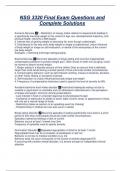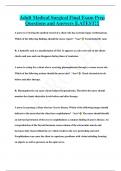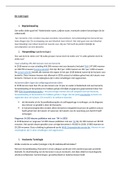NSG 3320 Final Exam Questions and
Complete Solutions
Anorexia Nervosa ✅1. Restriction of energy intake relative to requirements leading to
a significantly low body weight in the context of age, sex, developmental trajectory, and
physical health. Severity is BMI based.
2. Intense fear of gaining weight or becoming fat, even though underweight.
3. Disturbance in the way one's body weight or shape is experienced, undue influence
of body weight or shape on self-evaluation, or denial of the seriousness of the current
low body weight.
Subtypes = restricting and binge-eating/purging
Bulimia Nervosa ✅Recurrent episodes of binge eating and recurrent inappropriate
compensatory behavior to prevent weight gain. Often shows in teeth from purging, could
be normal or above normal weight.
1. Binge: eating in a discrete amount of time (within 2hrs) an amount that is definitely
larger than most would during a similar period of time and under similar circumstances.
2. Compensatory behavior: such as self-induced vomiting, misuse of laxatives, diuretics,
or other meds, fasting or excessive exercise.
3. Self-evaluation is unduly influenced by body shape and weight
4. Frequency of compensatory behaviors used to specify the level of severity for BN.
Avoidant/restrictive food intake disorder ✅Restrictive/inadequate eating not due to
medical or psychiatric co-morbidity and not attributed to disturbances in the perception
of shape and weight. Common clinical presentations:
- Lack interest in food or a blunted response to physiological hunger
- Avoidance of eating due to dislike of smell, taste, texture, temp, or appearance of food,
will only eat a narrow range of foods
- Restricting intake as reaction to an upsetting event (ie choking)
- Predominantly in children but can also occur in adults
Binge eating disorder ✅Recurring episodes of eating significantly more food in a short
period of time than most people would eat under similar circumstances.
Episodes marked by feelings of lack of control
Behavior occurs at least 1x/week over 3mo
Frequency of episodes used to specify severity
Rumination Disorder ✅Repeated regurgitation of food for at least 1 month
Regurgitated food may be re-chewed, re-swallowed, or spit out
Behavior is not due to medical condition (e.g. GI)
Behavior does not occur exclusively in the course of another diagnosed ED
If occurring with another mental disorder, it is severe enough for independent clinical
attention
,Pica ✅Persistent eating of nonnutritive substances for at least one month.
Behavior is inappropriate to developmental level
Behavior is not a part of a culturally sanctioned practice
If occurring with another disorder (ASD) or condition (pregnancy), it is severe enough
for independent clinical attention.
Eating disorder commonalities ✅Significant dissatisfaction with weight and shape
Practicing weight control behaviors
Evaluation of self based on weight and shape
Low self-esteem
Secrecy
Ego-syntonic = reluctance to change
Sense of guilt, shame, failure
Illogical
Not about food!
Evolve as coping strategies
Resulting "benefits"
Comorbidities to eating disorders ✅Depression and anxiety disorders (particularly
social phobias)
Incidence of OCD is as high as 25% in individuals with anorexia nervosa
Personality disorders may occur in 42-75% of individuals with eating disorders
Link exists between trauma and eating disorders
Tryptophan ✅available only through diet, temporary drop in consumption can limit
symptoms of anxiety but prolonged can give dysphoria and this cycle of temporary relief
followed by dysphoria sets up a positive feedback loop that reinforces disordered eating
behavior
Effects of starvation ✅Changes of eating habits: eating in silence, prolonged eating
time, unusual mixing of food, preoccupation with food
Social changes: men became withdrawn, decreased wish to socialize, less humor
Cognitive changes: impaired concentration, impaired comprehension and judgment
Emotional changes: depression, irritability, frequent outbursts of anger, extreme mood
swings, high levels of anxiety (nail biting), almost 20% experienced extreme emotional
deterioration (some hospitalized).
Most changes persisted through refeeding, became worst for some.
Psychological consequences of eating disorders ✅anxiety, irritability, sadness, mood
fluctuations, sleep difficulties, crying frequently, poor attention, withdrawal from family
and friends, poor concentration, poor memory, increased self-consciousness, changes
in relationships with friends and family
, Effects of eating disorders on families ✅Families tend to reorganize themselves
around the illness leading to:
Effects on caregiver-child relationships
Effects on sibling relationships
Effects on partner relationships
New behaviors and patterns within families
Possible maintenance of the illness
Anorexia nervosa nursing assessment ✅severe electrolyte imbalance (as a result of
purging, severely underweight, mottled/cool skin, low BP/pulse/temp, history of dieting,
mental status, value attached to weight, perception of problem
Anorexia nervosa acute care ✅Immediate medical stabilization is required if a client
has extreme electrolyte imbalances or is below 85% of their ideal weight.
Inpatient medical management may be required when nutrition therapy is initiated due
to refeeding syndrome (complication involving alterations in electrolytes, vitamin
deficiencies and sodium retention)
Refeeding syndrome ✅Metabolic disturbances that occur as a result of reinstitution of
nutrition to patients who are starved, severely malnourished or metabolically stressed
due to severe illness. Happens with anorexia nervosa.
Anorexia nervosa nursing interventions ✅Pharm: SSRIs to reduce obsessive-
compulsive behavior, antipsychotics (chlorpromazine) helpful for delusional or
overactive patients, atypical antipsychotics (olanzapine) help in improving mood and
decreasing obsessive behaviors.
Psychotherapy: normalizing eating habits
Psychosocial: weight-restoration program for incremental weight gain, milieu therapy
Bulimia nervosa nursing assessment ✅often at or slightly below or above ideal body
weight, enlarged parotid glands, dental erosion, electrolytes, dehydration, social
functioning, mental status
Bulimia nervosa nursing interventions ✅Acute care: cognitive-behavioral therapy used
to normalize eating habits is gold standard
Pharm: antidepressants
Milieu management: stopping the cycle of binging and purging
Counselling
Health teaching and health promotion
Binge eating disorder nursing interventions ✅Pharm: SSRIs helpful in short term but
clients often regain weight once discontinued
CBT
Interpersonal therapy






